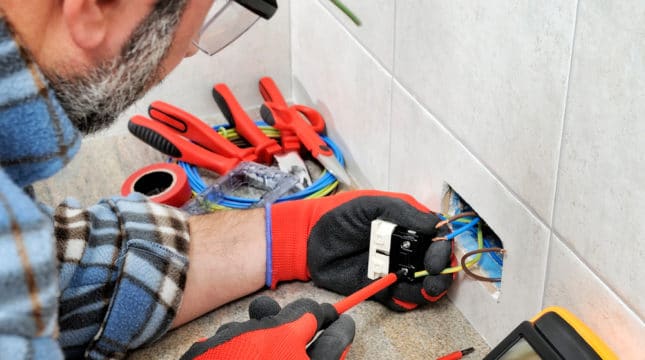Let’s dive into the seven most valuable deductions electricians should remember.
1. Home office deductions
Many electricians who are sole proprietors use their homes to store business property or manage the administrative side of their operations. If you have dedicated a section of your home for business use, the Internal Revenue Service (IRS) allows what’s known as a home office deduction.
There are two ways to calculate this deduction, and your accountant or tax software will reveal which method yields the more significant write-off.
You can use the regular method, which divides the square footage exclusively devoted to your business by the total square footage of your home. You can then apply that percentage to utilities, home insurance, property taxes and mortgage interest. You can also deduct depreciation on your home.
Of course, keeping track of all those expenses throughout the year can be tricky (although they might yield a larger deduction if you do), which is why there is also the simplified option. This option allows a deduction of five dollars per square foot of dedicated business space, up to 300 square feet.
2. Vehicle expenses and mileage
In all likelihood, you own a vehicle to get you from job to job. Like the home office deduction, you have two options to consider.
During the calendar or fiscal year, you can keep track of all the expenses shelled out for your business vehicle, including gas, oil, tires, repairs, etc. The total you arrive at (with receipts to back it up!) may be deducted as a business expense.
On the other hand, you can just keep track of your business mileage and take the IRS rate of 58 cents per mile as your deduction. Like the home office deduction, you’ll want to use the method that gives you the largest write-off.
Regarding vehicles, it’s worth noting that purchasing a light truck or SUV also affords you some considerable tax advantages. Vehicles with a rating that equals or exceeds 6,000 lbs. in gross vehicle weight rating (GVWR) are eligible for a tax deduction that can amount to 100% of the purchase price. However, if you buy a $30,000 pickup and use it 80% of the time for business, you can only write off $24,000 or the percentage of cost related to business use.
3. Equipment and supplies
As a self-employed electrician, you can deduct any tools, wiring, outlets, supplies, and more you buy for customer jobs. However, depending on the cost of the equipment, you may need to spread the deduction out over several years.
It all depends on the useful life of the asset. You can buy office supplies such as printer ink and take the total purchase amount right off your taxable income.
With an asset expected to last five years or more, such as a supply shed, you’ll need to depreciate the item and spread the cost out according to the useful life in years that the IRS applies to the structure.
4. Utilities for electricians
We looked at utilities as part of the home office tax deduction, but the amount you can deduct changes when you own a building devoted exclusively to your business pursuits.
You may own a small garage or storefront where you store tools and park your van. Unlike a home office where you can only take a percentage of the utilities when you own a separate space for business, you can deduct every dollar.
You might even use space in that building for an office. As long as the building is entirely dedicated to your business, you can deduct from your business income everything you spend on heating, cooling, water, electricity, internet, phones, and more.
5. Self-employment taxes
By now, you’re aware that paying taxes is all on you.
As a self-employed electrician, you will need to pay quarterly estimated income taxes based on the amount you’ve earned and expect to earn for the balance of the year.
In addition to federal income tax obligations, you’ll also notice that payroll deductions for Social Security and Medicare are supplanted by a self-employment tax, which is 15.3% in total of 2023 net earnings up to $142,800.
This 15.3% comes because you are paying taxes as an employee and an employer as a self-employed individual. Knowing this to be a bit unfair, once you calculate the self-employment taxes you owe, the IRS allows you to deduct half of that self-employment tax figure from your taxable income.
6. Business insurance
As an electrician, you might need a license to stay in business, and you’re probably required to have insurance to maintain that license. Even if it’s not required for the job, having insurance is smart business and an easy and affordable way to protect the business you’ve built.
Luckily, when it comes to business insurance, the costs are deductible. That’s one more item you can check off your electrician tax deduction checklist.
Whether you keep general liability insurance to help protect you when working on other people’s property or carry workers’ compensation insurance to help ensure your employees are covered in case of an accident, you can write off the costs.
7. Sales and marketing
You need to let the public know what you do and where you’re located, so electrician marketing and advertising ideas are a worthy investment.
Whether you choose print, promotional items, radio or paid social media campaigns, know that the entire cost comes off the top of your taxable income.
That means if you brought in $100,000 worth of revenue in a year and spent $12,000 in marketing and advertising costs, your taxable liability immediately decreases to $88,000 (Without even considering all the other deductions we just went over!).
How NEXT helps support electricians
NEXT lets you manage your insurance coverage 24/7 via web or mobile app. We can help you put together a comprehensive electrician insurance plan designed just for you.
NEXT has helped hundreds of thousands of small businesses find the right business insurance coverage at an affordable price.
Get a quote, review your options, purchase coverage and secure your certificate of insurance in under 10 minutes.
Start a free quote with NEXT.





